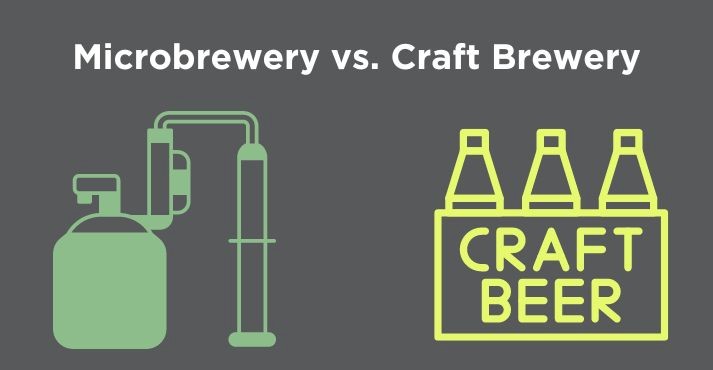The number of microbreweries in Asia is rising, which highlights their rising popularity and cultural impact.
According to Statista, the revenue of the Beer industry in Asia is expected to grow by US$193.2bn in 2024.
But what is a microbrewery?
A microbrewery is a small-scale brewery that produces limited quantities of beer. It often focuses on quality, flavor, and innovative brewing techniques.
Unlike large corporate breweries that produce draft beer, microbreweries emphasize local ingredients and unique recipes, creating craft beers that stand out in the market.
Understanding microbreweries is essential for businesses in the beverage industry. Their products appeal to a growing segment of consumers seeking distinct, high-quality beer experiences.
Partnering with microbreweries can enhance your brand’s reputation, attract new customers, and support local economies.
This blog will explore what makes microbreweries unique and why they are valuable to your business offerings.
What is a Microbrewery?

A microbrewery is a small-scale brewery that produces limited quantities of beer. It is typically much smaller than large-scale corporate breweries.
These establishments prioritize quality, flavor, and innovation, often experimenting with unique recipes and brewing techniques.
Microbreweries focuses on creating distinct craft beers that stand out in the market, emphasizing local ingredients and personalized brewing processes.
Their smaller production scale allows them to maintain a high level of control over the brewing process, ensuring each batch meets their exacting standards for taste and quality.
Key Characteristics of a Microbrewery

Here are the critical characteristics of microbreweries that can help you understand what sets them apart from others.
- Limited Production: Microbreweries produce beer in small quantities, often capped at a specific number of barrels per year. This limited production allows for greater attention to detail and quality control in every batch.
- Local Distribution: Most microbreweries distribute their products locally or regionally, creating a solid connection with their community. This local focus helps them build a loyal customer base and support nearby businesses.
- Artisanal Brewing Methods: Microbreweries emphasize traditional and artisanal brewing methods, often incorporating handcrafted techniques and unique ingredients—this dedication to craftsmanship results in innovative and diverse beer offerings.
- Focus on Quality and Uniqueness: Microbreweries prioritize creating high-quality, unique beers that stand out from mass-produced options. They often experiment with different flavors, styles, and brewing processes to deliver distinctive and memorable beers to their customers.
Understanding these characteristics can help businesses appreciate the value microbreweries bring. They offer unique products, such as gluten-free beer, that cater to the growing demand for craft beer.
History and Evolution of Microbreweries

The history and evolution of microbreweries are fascinating journeys that highlight the shift from large-scale industrial brewing to small-scale artisanal production.
Originating as a response to the homogenization of beer by large breweries, microbreweries have become a trend in the beverage industry, celebrated for their quality, creativity, and local focus.
Origins
The microbrewery movement began in the 1970s, primarily in the United States and the United Kingdom.
In the U.S., figures like Fritz Maytag of Anchor Brewing Company and Jack McAuliffe of New Albion Brewing are often credited as pioneers.
Maytag’s purchase of Anchor Brewing in 1965 and his focus on traditional brewing methods set the stage for the craft beer revolution.
McAuliffe founded New Albion Brewing in 1976, one of the first new small breweries in the U.S. since Prohibition.
In the U.K., the Campaign for Real Ale (CAMRA), established in 1971, played a crucial role in promoting traditional brewing methods and real ales, inspiring the growth of microbreweries.
Global Spread
The concept of microbreweries soon spread beyond the U.S. and the U.K., gaining traction in Europe, Australia, and Asia.
In Europe, countries with rich brewing traditions, such as Belgium and Germany, saw a revival of small breweries focused on artisanal techniques.
Australia embraced microbrewery in the 1980s, emphasizing innovative styles and high-quality ingredients.
Southeast Asia has also seen an expanding microbrewery scene, with countries like Thailand, Vietnam, and the Philippines experiencing a rise in craft beer culture.
Local breweries experiment with unique ingredients and flavors reflecting regional tastes and traditions.
Recent Trends
Several key trends have shaped the microbrewery industry in recent years. The rise of craft beer culture has increased demand for unique, locally sourced brews that offer distinctive flavors and stories.
Consumers seek beers with innovative ingredients, such as exotic fruits, spices, and locally-grown hops. There is also a growing emphasis on sustainability, with microbreweries adopting eco-friendly practices and sourcing ingredients from local farmers.
Additionally, the popularity of brewpubs and taprooms has surged, providing consumers with a direct connection to the brewing process and promoting a sense of community around craft beer.
The evolution of microbreweries reflects a broader shift towards quality, innovation, and localism in the beverage industry.
How Microbreweries Differ from Other Breweries?
Microbreweries are distinct from other breweries in several vital aspects, including production scale, brewing techniques, and market focus.
Understanding these differences is crucial for businesses in the beverage industry, as it allows them to position their products better and cater to diverse consumer preferences.
Below, we explore how microbreweries differ from craft breweries, macrobreweries, and nanobreweries.
Microbrewery vs. Craft Brewery

Microbreweries and craft breweries often overlap, but they are not identical. A microbrewery is defined primarily by its small production scale, typically producing less than 15,000 barrels of beer per year and selling most of its beer locally.
The term “craft brewery” is broader, including small-scale production and a focus on traditional brewing methods, quality ingredients, and innovation.
Craft breweries may include microbreweries but can include slightly larger operations that still prioritize artisanal brewing techniques.
The critical difference lies in the emphasis:
“While all microbreweries can be considered craft breweries due to their scale and quality focus, not all craft breweries are microbreweries if they produce beer on a larger scale.”
Craft breweries might produce more than 15,000 barrels annually but still adhere to principles of independence, traditional methods, and high-quality ingredients.
Microbrewery vs. Macrobrewery
The contrast between microbreweries and macrobreweries is stark, particularly regarding production scale, distribution, and brewing techniques.
Macrobreweries are large-scale commercial breweries that produce millions of barrels of beer yearly.
These breweries focus on mass production and wide distribution, often using highly automated processes and standardized recipes to ensure consistency and efficiency.
In contrast, microbreweries produce limited quantities of beer, which allows them to experiment with unique flavors and brewing methods.
This small-scale production often results in a higher level of quality control and the ability to create distinct, artisanal beers.
Microbreweries’ distribution is typically local or regional, fostering a strong connection with the community and reducing the environmental impact of long-distance shipping.
Microbreweries also prioritize traditional and hands-on brewing techniques, including using local ingredients and experimenting with different fermentation processes.
This focus on innovation and quality often leads to a more diverse and dynamic range of beer offerings compared to the more uniform products of macrobreweries.
Microbrewery vs. Nanobrewery
Nanobreweries are smaller than microbreweries, often defined by their three barrels or less production capacity per batch.
These extremely small-scale operations are typically run by a single brewer or a small team and often focus on highly experimental and niche beer styles.
While both microbreweries and nanobreweries emphasize quality and innovation, the production scale is the primary differentiator.
Nanobreweries can afford to take more significant risks with their brewing techniques and ingredients because their small batches minimize the financial impact if a particular brew is unsuccessful.
This allows nanobreweries to push the boundaries of brewing creativity and offer highly unique, limited-edition beers.
Though still relatively small, microbreweries have a larger production capacity and often a more established distribution network than nanobreweries.
By recognizing microbreweries’ unique attributes and advantages, businesses can make informed decisions about partnerships, product offerings, and marketing strategies to meet their customers’ evolving preferences.
Why Microbreweries Matter

Microbreweries play a significant role in the beer industry and beyond, offering unique contributions that distinguish them from more extensive brewing operations.
They prioritize quality and flavor, promote local communities and culture, and often adopt sustainable practices that benefit the environment.
Understanding why microbreweries matter can help businesses and consumers appreciate their value and support their growth.
Quality and Flavor
One of the primary reasons microbreweries matter is their commitment to quality and flavor. Unlike large-scale breweries, focusing on mass production and consistency, microbreweries can experiment with different ingredients, brewing techniques, and recipes.
This focus on craftsmanship results in unique and diverse beer offerings that cater to a wide range of tastes.
Microbreweries can also produce limited-edition and seasonal brews, providing consumers with new and exciting options throughout the year. This dedication to quality and innovation differentiates microbreweries from their larger counterparts.
It helps them build a loyal customer base that appreciates their creative approach to brewing.
Community and Culture
Microbreweries are integral to the communities they serve. They often act as social hubs where people gather to enjoy good beer and company.
Many microbreweries host events, such as live music, trivia nights, and beer tastings, promoting community and belonging.
Furthermore, microbreweries contribute to local economies by creating jobs, supporting local farmers and suppliers, and attracting tourists. Their emphasis on localism helps strengthen community ties and promotes a culture of collaboration and mutual support.
By celebrating regional flavors and traditions, microbreweries also play a vital role in preserving and promoting local beer culture, which can be a source of pride and identity for the community.
Sustainability
Sustainability is another important aspect of why microbreweries matter. Many microbreweries are committed to environmentally friendly practices that help reduce their carbon footprint.
These practices include using energy-efficient brewing equipment, implementing waste reduction and recycling programs, and sourcing ingredients from local, sustainable farms.
Due to their limited production scale and local distribution, microbreweries often have a more minor environmental impact than large breweries. This reduced scale can lead to lower energy consumption and fewer emissions associated with transportation and logistics.
Additionally, some microbreweries engage in innovative sustainability initiatives, such as water conservation efforts, composting spent grains, and using renewable energy sources.
By prioritizing sustainability, microbreweries contribute to broader efforts to protect the environment and promote responsible consumption.
Environmentally conscious consumers can feel good about supporting microbreweries that share their values and are actively working to impact the planet positively.
Microbreweries matter because they bring a unique blend of quality, community, and sustainability to the beer industry.
Supporting microbreweries enhances our beer-drinking experiences and contributes to the well-being of our communities and the environment.
Examples of Successful Microbreweries in Southeast Asia
Southeast Asia is home to many successful microbreweries gaining popularity for their unique and high-quality craft beers.
These microbreweries are not only creating diverse and flavorful brews but are also promoting vibrant local beer cultures.
Below, we explore some notable examples of microbreweries in Singapore, Malaysia, and Thailand that significantly impact the region.
Microbreweries in Singapore
Little Island Brewing Co.

Located in the coastal area of Changi Village, Little Island Brewing Co. is a standout in Singapore’s microbrewery scene. This brewery is known for its wide range of craft beers brewed on-site, focusing on quality and innovation.
The spacious and relaxed setting has become a popular spot for locals and tourists to enjoy fresh, flavorful beers.
Brewerkz

Another pioneer in Singapore’s craft beer industry, Brewerkz, has been serving award-winning beers since 1997.
Located along the scenic Singapore River, Brewerkz offers an extensive selection of handcrafted beers, including seasonal and limited-edition brews. Their commitment to quality and consistency has made them a local craft beer community staple.
Microbreweries in Malaysia
Taps Beer Bar

Taps Beer Bar, located in Kuala Lumpur, is a leading name in Malaysia’s microbrewery landscape. Known for its impressive selection of craft beers worldwide, Taps also produces its unique brews.
The bar provides a welcoming atmosphere for beer enthusiasts to explore and enjoy diverse beer styles.
The Great Beer Bar

Located in Petaling Jaya, The Great Beer Bar is celebrated for its curated selection of local and international craft beers.
They focus on promoting Malaysian craft beers, including their creations, which feature innovative flavors and high-quality ingredients.
The bar has become a favorite spot for those seeking to experience the best of Malaysia’s craft beer scene.
Microbreweries in Thailand
Mikkeller Bangkok

Mikkeller Bangkok is part of the renowned Mikkeller brand, which originated in Denmark. This Bangkok location offers many of Mikkeller’s signature brews and unique, locally inspired beers.
Known for its laid-back vibe and rotating taps, Mikkeller Bangkok has become a key player in Thailand’s craft beer revolution.
Full Moon Brewworks

Based in Phuket, Full Moon Brewworks is one of Thailand’s pioneering microbreweries. It produces a range of distinctive beers, including its flagship brew, Chalawan Pale Ale, which has gained international recognition.
Full Moon Brewworks emphasizes quality and creativity, contributing significantly to the growth of Thailand’s craft beer market.
These examples illustrate the dynamic and thriving nature of the microbrewery industry in Southeast Asia.
Each of these microbreweries brings something unique through innovative brewing techniques, a focus on local ingredients, or fostering a community-centric beer culture.
Their success stories highlight the region’s growing appreciation for craft beer and the potential for further growth and innovation.
Frequently Asked Questions (FAQs)
How much does it cost to start a microbrewery?
Starting a microbrewery typically costs between $250,000 and $1 million, depending on location, size, and equipment. Expenses include brewing equipment, leasing or purchasing a facility, and obtaining necessary licenses.
What is the oldest microbrewery in the world?
The oldest microbrewery in the world is believed to be Weihenstephan Brewery in Germany, founded in 1040. It is still operational and renowned for its traditional brewing techniques and high-quality beers.
Which is the largest microbrewery in the world?
The largest microbrewery in the world is often considered to be Samuel Adams (Boston Beer Company) in the United States. It started as a microbrewery and grew significantly, still retaining its craft beer identity.
Conclusion
Microbreweries have revolutionized the beer industry with their commitment to quality, community, and sustainability.
By producing unique and flavorful brews, fostering local culture, and adopting environmentally friendly practices, they offer a refreshing alternative to mass-produced beers.
The success of microbreweries in Southeast Asia, such as Little Island Brewing Co., Taps Beer Bar, and Mikkeller Bangkok, highlights the region’s growing appreciation for craft beer.
Whether you are a beer enthusiast or a business looking to invest in the craft beer market, understanding what a microbrewery is, along with the value and potential of microbreweries, is essential.
Supporting microbreweries enhances your beer experience and contributes to local economies and sustainable practices.





























